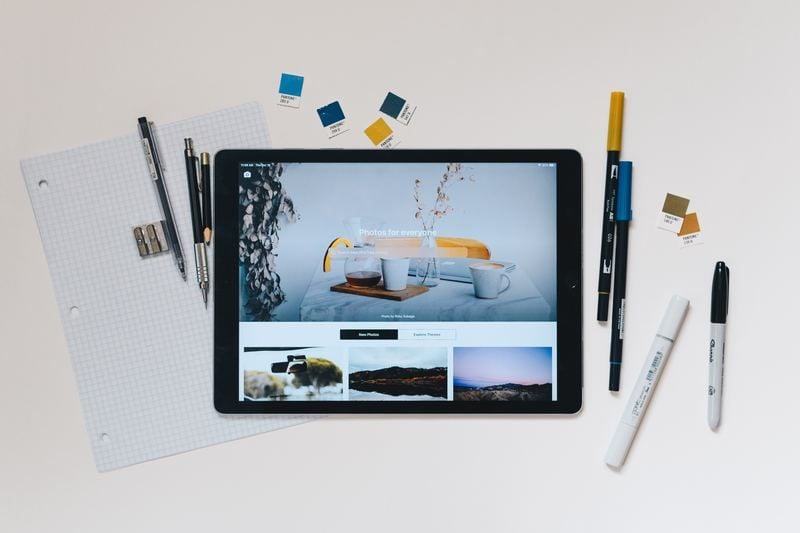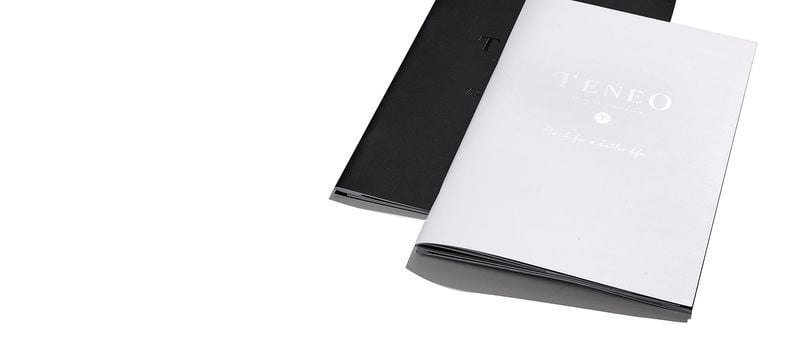Common print mistakes (and how to fix them)
)
Preparing artwork for print can be a little daunting (even for experienced designers), but hope is not lost; there are simple steps you can follow to ensure your print will come out trumps.
If you're a rookie and want to get results like a pro, make sure you avoid these common design mistakes...
Wrong document size
Whether you're printing Business Cards or banners, it's vital that your artwork is the right size. Trying to print an Instagram photo on a banner stand isn't going to look very good, so set your size and units when you make your document, and check your dimensions. Oh, and don't forget to add bleed.
Working in the wrong resolution
Less of a problem in Illustrator, more of a problem in Photoshop; working in the wrong resolution can cause problems when going to print. Most documents are printed at 300dpi, unless you move up to large format printing, which is sometimes set at 150dpi. For everyday documents like Flyers, Business Cards and Stickers, stick with 300dpi. Printers produce colour by combining thousands of dots, like pointillist art. If you have 300 of those dots in a square inch it is considered the standard for good quality print. A resolution above 300dpi is unnecessary for your print you won't spot the difference unless you're looking through a magnifying glass.
Forgetting to add 'Bleed'
Bleed is an area of print at the edge of the document that gets trimmed off after printing. That means you need to make your artwork slightly bigger, so it can be trimmed down to the right size. When print is cut to size, the cut isn't always 100% accurate. If you don't add bleed, you risk having a white line at the edge of your print where the artwork ends. Luckily, adding bleed is pretty straight-forward you can find out how to do it here.
Working in the wrong colour mode
Choosing the wrong colour mode is a classic print design error that's been known to trip up rookies and well-seasoned designers alike. If you're wondering how to prepare a design for print at a professional printer, always remember to stick to CMYK colour mode (cyan, magenta, yellow, black).
Documents for print need to contain information for all four colours in the print head; cyan, magenta, yellow and black. The first three are primary colours and the black is used to mix darker versions (shades) of those colours.
"Colour that comes from illuminated light-sources (computer screens, let's say) is described as 'additive' (RGB) colour: red, green and blue. Everyday colour, including print, is known as 'subtractive' (CYMK) colour. Before you knuckle down in Illustrator, Photoshop, whatever your weapon of choice, make sure you switch to CMYK colour mode."
Using the wrong values for black colour
When printing large areas of black, it's better to include more than just black in your CMYK value. Printers lay colour down in layers, and adding extra colour helps stop the paper from showing through, creating a richer black. 'Rich' black is great for large areas, but for text it's better to use a simple 100% black. This is because if the colours aren't perfectly aligned, your text won't be so sharp.
CONTACT US with all your printing questions and needs.
{Source: Printed Blog}
| Posted in:FeaturedDigitalpress Masterclass |
Updating Your Pantone Guides Can Save You Valuable Production Time and Money!
)
You are also likely viewing faded, yellowed, or otherwise inaccurate colour, meaning the colour that you're looking at isn't necessarily the same as what your vendors are seeing or the same as what will be produced. This can lead to a lot of extra rework, time, and money.
When you, your supply chain, or your manufacturing partners are making color critical decisions like reviewing press proofs or production samples working from up-to-date guides and chip books can avoid a lot of headaches, such as:
- Miscommunication
- Multiple rounds of re-sampling
- Freight costs for re-shipping physical proofs
- On-press validation visits, equaling resource, time, and travel expenditure
- Frustration
- On-time launch or delivery risk
HERE ARE SOME REASONS WHY:
Aging and Usage Effects: Is My Colour Still Accurate?
Pantone Guides and Books are produced and measured against high manufacturing standards. With each publication, you can appreciate:
- Highly-regulated ink formula consistency and overall printed quality
- During production, we sample each print run once every 200 sheets aiming at a CIEDE2000 of 2.0 or less, with an attainment rate of 96% in 2018
- Printed on popular commercial-grade 100 lb. and 80 lb. text weight paper stocks
- Colours visually and digitally aligned to the 2010 Pantone Master Standards
Despite all of this, no printed product can last forever. The colours in your Pantone Guide or Chip Book may appear inaccurate over time as a result of handling, fading, improper storage, and light exposure, among other factors. This is why we recommend replacing your guides every 12-18 months, depending on your usage case and storage habits.
- Handling = smearing and removing pigment from natural oils on fingertips
- Pages rubbing together = scratching or removing pigment
- Light exposure = fading
- Paper aging = yellowing effects
- Ambient moisture = accelerated paper aging
- Natural pigment expiration = faster, noticeable colour variation, especially in lighter and pastel colours
ARE YOU SHORT ON COLOUR?
Since (Pantone) launched the Pantone Plus Series back in 2010, there have been three colour collection additions. Check out the chart below you could be missing over 750 colours!
Missing colours could mean lost time locating the colours that your clients and brands might be asking for that should be right at your fingertips. Also, remember that the colours we add are often derived from trend forecasting and market demand, which means keeping up with what's relevant and important in today's world.
PRODUCTION GUIDES: IS MY VENDOR LOOKING AT THE SAME COLOUR?
If your guide is new but your printer's guide is even just a few years older, then your colors may no longer accurately match, which can cause unnecessary frustration, costs, and delays. Encouraging your manufacturing and supply chain partners to also keep their guides up to date can help mitigate this situation. However, this is often easier said than done, and knowing this, Pantone recommends that you always accompany your artwork and design files with a physical representation of your desired colour as the precise colour intent to strive for on-press.
(Source: Pantone)
The rise of B2B print media
)
Discover why B2B is one of the few areas of publishing and marketing that's on the up. (Clue: it's all about trust)
In these turbulent times, magazines and newspapers are fighting hard to maintain circulation and share of attention in an increasingly fragmented media landscape. But while the consumer titles chase after the increasingly elusive advertising and sales revenue, there's one area of print media that's thriving: business to business (B2B).
B2B media in all its forms is currently one of the most successful sectors of publishing and marketing. Whether it's newspapers (the Financial Times was one of only two UK newspapers to increase circulation year on year), magazines (The Economist is now the UK's best selling business weekly) or direct mail and door drop (the annual net spend by UK businesses on door drop was an impressive £263m in 2017). Clearly, businesses are seeing the value in print and investing both their attention and their budgets into the medium.
"Traditional print media provides consumers with a personal experience, something tangible they can interact with, take with them and go back to at their own leisure," says Rachel Aldighieri, Managing Director of the DMA. "Its unique nature makes it a robust advertising medium and the figures over the past few years reflect this."
The commodity of trust
The benefits for companies in using print are well known: its pinpoint targeting, lean-back qualities and ability to stick around as a permanent reminder of a business offering all raise its ROI levels above those of other marketing media. But in the past 12 months, another factor in the success of B2B print has emerged trust.
For a successful business, trust is one of the most important values it can possess. Trust in its products, trust in its service, trust in its people it's a commodity that's difficult to build but easy to lose. The latest Edelman Trust Barometer has shown that traditional media has witnessed a rebound in public confidence, reaching a record high of 61%, an increase of 13% year on year. Taken with the fact that 63% of people turn to print for a deeper understanding of a news story (Two Sides, 2018), it's clear that customers, whether business or consumer, have a closer affinity with print than online media.
"I think that the mass of digital information and the way it's so instant is working against it," says Phil Alexander, Joint Managing Director of paper merchant GF Smith. "We are realising that digital is a fleeting experience and we don't get any feeling of ownership or any real connection with it."
Building value and confidence
Another area in which B2B print media is thriving is customer magazines. Keen to make a personal connection between their business and their customers, companies from all sectors of industry are investing in high quality publications that not only keep key clients and prospects up to date with their services and products, but provides an exclusive insight into their business and its people.
The magazine created for Swedish mining and construction specialists Epiroc is a fantastic case in point. Simply titled Mining & Construction, the biannual publication tackles complex issues within the industry, giving the high value business reader a combination of industry trends, company news and key benefits for its customers.
"The magazine focuses on the bigger picture and how we would like to help our customers and partners to make good things even better," says Anna Dahlman Herrgård, Global Communications & Brand Manager at Epiroc. "The M&C concept helps us to build trust. It allows us to share our expertise and show real examples of how our customers can rely on us as a partner."
Reliability in an unreliable world
With stability in the business world unlikely to improve in the next few years, many companies are searching for ways to build confidence in their brand and products, demonstrating authority and expertise in their respective fields, and creating a long-lasting relationship with customers. And print has proved time and time again that it's the perfect business partner.
CONTACT US about all your printing needs.
(Source: Two Sides)
The Coffee Cup Conundrum
)
With over seven million cups going to landfill every day, having your daily coffee is turning into a serious environmental problem. So what's the solution?
A few years ago, the most pressing concern of most high street coffee drinkers was whether the bored-looking barista had spelt their name right. Now, in a new era of single-use plastic awareness, many will look at their takeaway cup and wonder where it will end up once the last drop of coffee has gone.
In the UK, over seven million disposable coffee cups are thrown away every single day, which stacks up to an astonishing 2.5 billion every year. But while many coffee companies promote the recyclable nature of their cups, the vast majority simply end up in landfill because of the challenge of separating the polyethylene from the paper.
Spurred on by the prospect of government legislation on plastic waste and the opportunity to enter such a huge and lucrative market, a number of packaging companies have been working on solutions to the problem, including compostable cups and reusable cups neither of which have caught the public's or the retail world's imagination. However, a third solution may just be the answer.
From bags to riches
Cumbrian paper manufacturer James Cropper have been working on recycling the fibre used in coffee cups since 2013, when they began formulating a method for separating the plastic from the paper. Once separated, they then use the recycled fibre to create premium papers used to make thousands of bags for upmarket retailer Selfridges, as well as packaging for Lush handmade cosmetics and the Extract paper range for specialist paper merchant GF Smith. This year they have already recycled 24 million coffee cups, with Costa, McDonald's and Starbucks all collecting their used cups to be recycled.
"We have a unique process at our mill to bring in used cups and upcycle them into new, beautiful paper products," explains Richard Burnett, Market Sector Manager at James Cropper. "Perhaps one reason why we've made it work is that we only recycle cups. We don't take any other type of recycled fibre, so we've been able to optimise the process to increase efficiency and quality."
The advantage to using recycled fibre from coffee cups is that, due to food safety regulations, the cups are manufactured using virgin fibre. So once it's recycled, it can be used to produce high quality paper that can itself be recycled again and again.
"From our perspective there's more value in recycling the fibre used in cups rather than being able to compost it," says Richard. "We are seeing a lot of interest in recycling fibre, with customers wanting a lot more recycled content in their products."
Capital effort
Another organisation that's seeing the potential in recycling coffee cups is Hubbub, a charity that works with big businesses to encourage people to change their behaviour towards the environment. Enlisting the support of companies such as Costa, Marks and Spencer, McDonald's, Nestlé, Pret A Manger, Starbucks and a group of the leading coffee cup manufacturers, they set up recycling bins in the City of London with the ambition to collect and recycle half a million coffee cups. By the end of the campaign, they had recycled over six million.
"The campaign actually started in Manchester in 2016 with one recycling bin to see what would happen," explains Trewin Restorick, CEO and Founder of Hubbub. "And it got broken into, because people were after the vouchers printed on the cups. But eventually that one bin collected over 35,000 cups and, taken with the Square Mile Challenge, we are now able to recycle coffee cups in the UK, which is a huge achievement."
The final countdown
With a report by the Environmental Audit Committee recommending to the government that disposable cups should either all be recycled by 2023 or be banned altogether, this is clearly an issue that needs to be tackled by the retailers, the recycling industry and the public alike. Whether a workable solution will be found in that time remains to be seen, but with a lot of people doing a lot of work in the recycling area, we may finally be seeing the end of coffee cup waste.
{Source: Two Sides}

)
